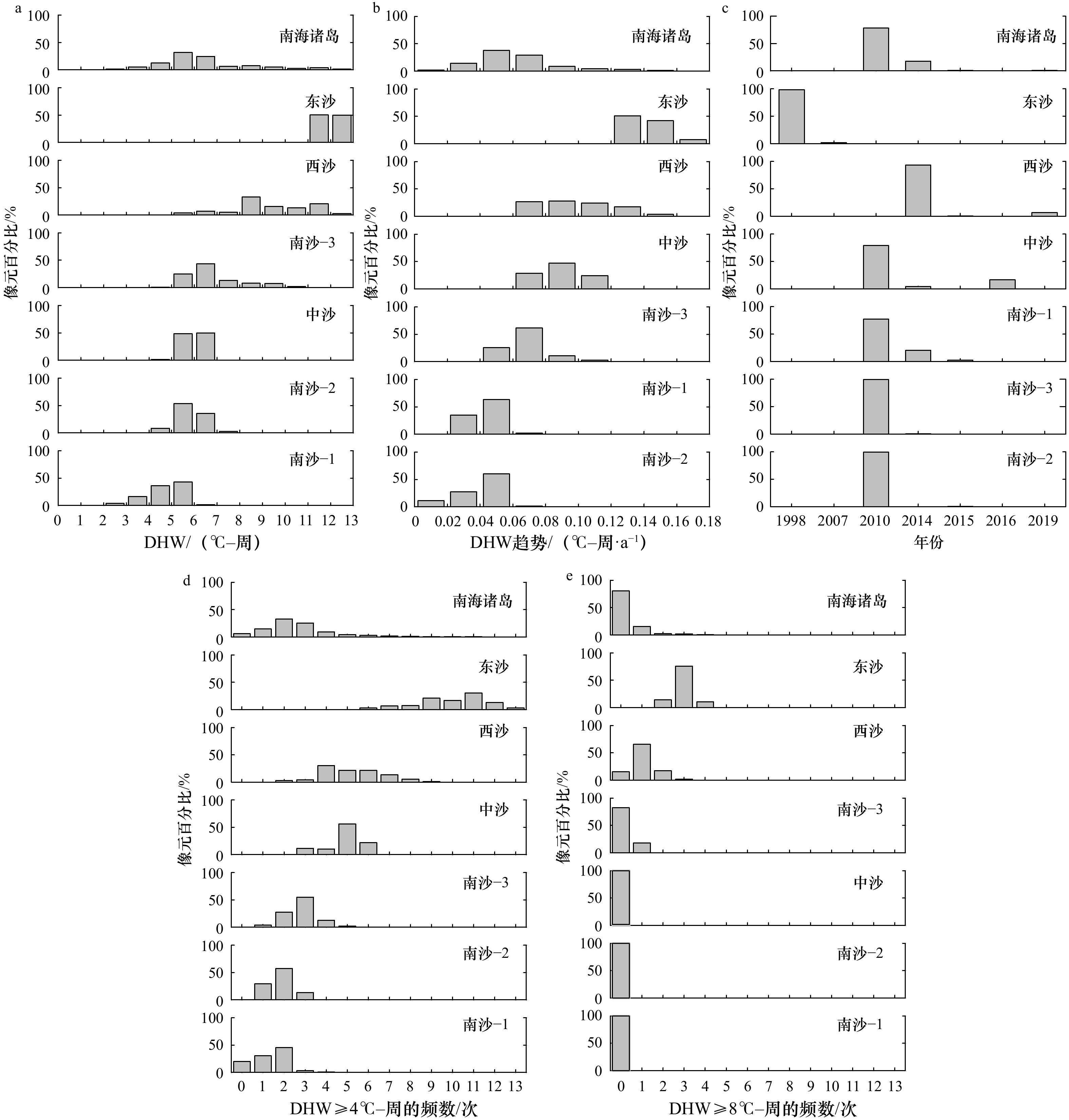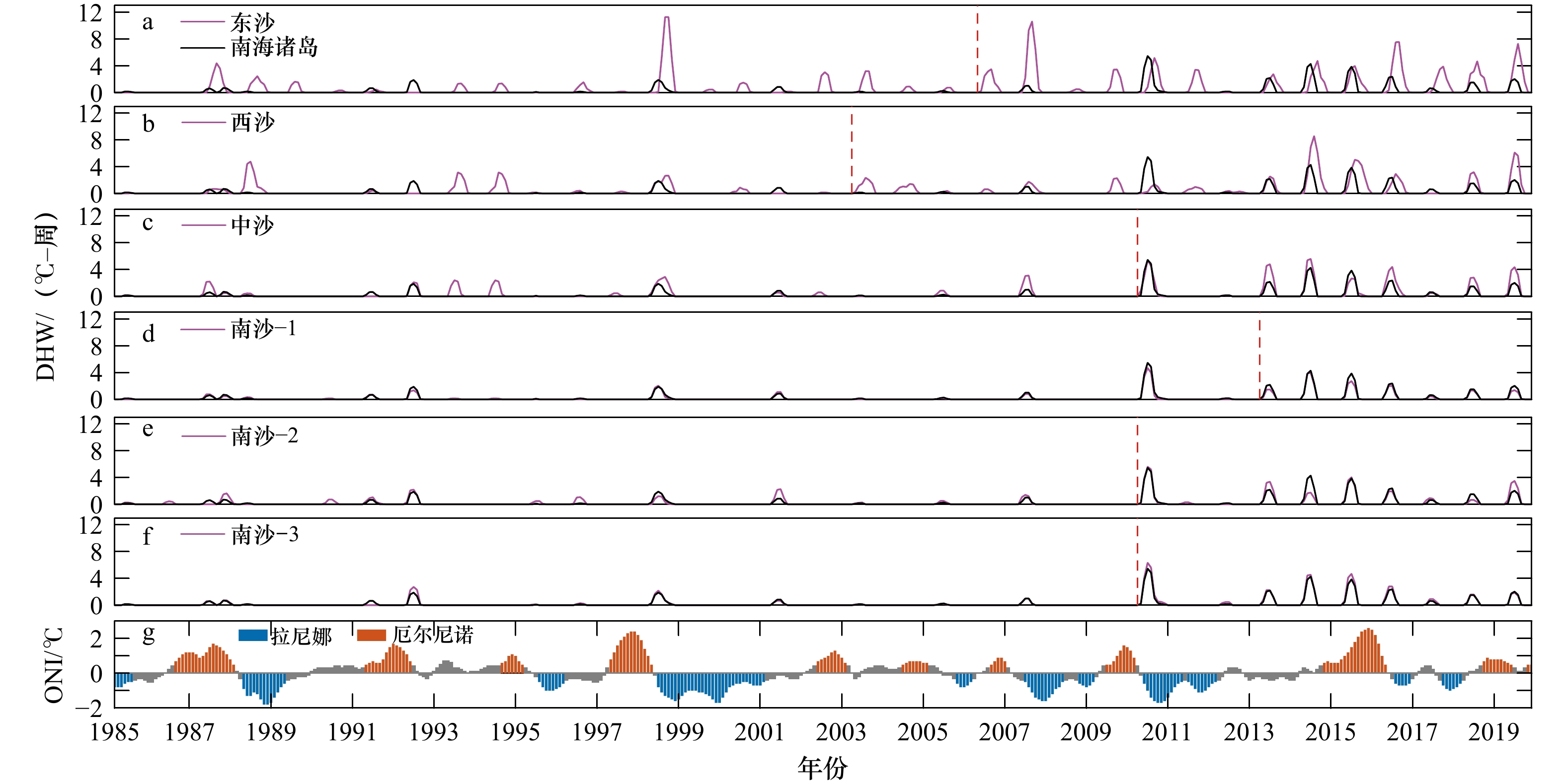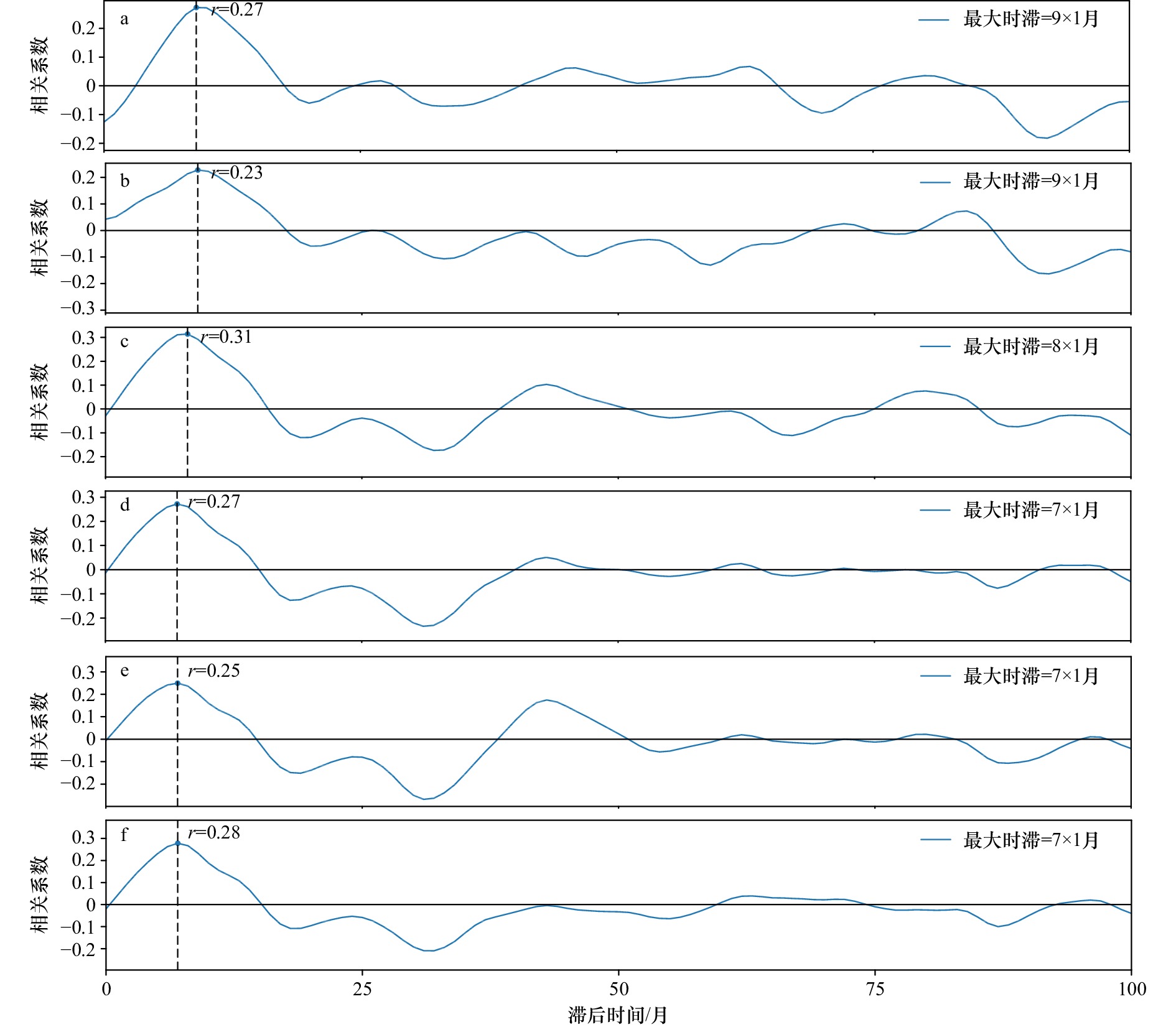Spatio-temporal variations of heat stress in coral reef regions over the South China Sea islands from 1985 to 2019
-
摘要: 全球气候变暖引起的热压力增大是南海诸岛珊瑚礁面临的最主要威胁,基于热压力对珊瑚礁白化的评估有利于对其保护和管理。周热度(Degree Heating Week , DHW)可以衡量热压力的强度和持续时间,代表过去连续12周珊瑚礁区海表温度(SST)正异常的累积。本文基于美国国家海洋和大气管理珊瑚礁监测计划(National Oceanic and Atmospheric Administration-Coral Reef Watch, NOAA-CRW)海表温度数据集,逐像元对35个年最大周热度数值进行K-means聚类分析,将南海诸岛珊瑚礁区分为6个区域:南沙–1、南沙–2、南沙–3、东沙、西沙和中沙珊瑚礁区。分析南海诸岛珊瑚礁区1985–2019年热压力时空变化及其与El Niño的相关关系。结果表明:(1)南海诸岛珊瑚礁区最大DHW为0~12.9℃−周,纬度上由高到低呈现减小变化规律。(2)线性拟合法分析1985–2019年的年最大DHW,显示南海诸岛珊瑚礁区热压力强度呈现上升趋势,为0.013~0.174℃−周/a,南海诸岛珊瑚礁区最大DHW出现在1998年、2010年、2014年。(3)年最大DHW可能造成93.9%的珊瑚礁发生超过一次白化的风险,19.6%的珊瑚礁发生超过一次死亡的风险。(4)南海诸岛珊瑚礁区的月均DHW和ONI交叉小波分析显示两者存在多时段8~32个月共振周期的时频特征和时滞相关性,证实南海诸岛珊瑚礁热压力随着厄尔尼诺事件发生而显著增大;时滞相关分析表明,ONI与南海诸岛珊瑚礁区热压力呈正相关关系,后者滞后于前者7~9个月的时间。Abstract: Increasing heat stress due to global warming is the main threat to coral reef regions over the South China Sea islands. Coral reefs bleaching events are most often predicted by heat stress, which will benefit the protection and management coral reefs. Degree heating week (DHW) is used to measure the intensity and duration of heat stress experienced on coral reefs, represents the accumulation of positive sea surface temperature (SST) anomaly at that location over the past 12 week periods. This study utilizes the National Oceanic and Atmospheric Administration-Coral Reef Watch (NOAA-CRW) SST dataset to investigate spatio-temporal in the heat stress of the coral reef regions of the South China Sea islands between 1985 to 2019 and its relevance to El Niño. K-means cluster analysis was performed on the 35-year maximum degree heating week values per pixel, and the coral reefs of the South China Sea islands were divided into 6 regions: Nansha−1, Nansha−2, Nansha−3, Dongsha, Xisha and Zhongsha coral reef region. The main results are as following: (1) The maximum DHW of the coral reef regions of the South China Sea islands is 0−12.9°C-week, and it decreases from high to low in latitude. (2) The linear fitting method was used to analyze the annual maximum DHW from 1985 to 2019. The results showed that the thermal pressure intensity in the coral reef area of the South China Sea islands showed an upward trend, ranging from 0.013°C to 0.174°C per week. The maximum DHW in the coral reef area of the South China Sea islands appeared in 1998, 2010, 2014. (3) The maximum annual DHW might have caused 93.9% of coral reefs to have more than one bleaching risk event, and 19.6% of coral reefs to have at least one risk of death. (4) The cross-wavelet analysis of monthly mean DHW in the coral reef regions of the South China Sea islands and Oceanic Niño index shows that there are time-frequency characteristics and time-lag correlation of multi-period 8−32 months resonance period, which confirms that the thermal pressure of coral reefs in the South China Sea islands increases significantly with the occurrence of El Niño events. The time lag correlation analysis shows that Oceanic Niño index is positively correlated with the thermal pressure in the coral reef regions of the South China Sea islands, and the latter lags behind the former by 7−9 months.
-
Key words:
- coral bleaching /
- degree heating weeks /
- heat stress /
- El Niño /
- South China Sea
-
图 1 南海诸岛珊瑚礁研究区
南海诸岛珊瑚礁区20 km缓冲(a)和K-means聚类分区(b)的地理空间分布(地图底图来自国家基础地理信息中心,网址:http://www.ngcc.cn/ngcc/)
Fig. 1 Location of coral reef regions in the South China Sea islands
Geographical distribution of 20 km buffer (a) and K-means clustering partition (b) in the coral reef regions of the South China Sea islands
图 3 1985–2019年南海诸岛珊瑚礁区热压力异质性变化
最大周热度(DHW)(a)、年最大DHW趋势(b)、最大DHW年份(c)、年最大DHW ≥ 4℃−周发生的频数(d)、年最大DHW ≥ 8℃−周发生的频数(e)的百分比直方图
Fig. 3 Heat stress heterogeneity changes in the coral reef regions of the South China Sea islands from 1985 to 2019
Percentage histogram of the distribution of maximum degree heating weeks (DHW) (a), annual trend of maximum DHW (b), maximum DHW value in each year (c), frequency of annual maximum DHW ≥ 4℃-weeks (d), frequency of annual maximum DHW ≥ 8℃-weeks (e)
图 5 东沙(a)、西沙(b)、中沙(c)、南沙–1(d)、南沙–2(e)、南沙–3(f)珊瑚礁区月平均周热度(DHW)和ONI的交叉小波能量谱
黑线包围区域内表示其通过5%显著性水平的标准红噪声检验。←表示El Niño与DHW为负位相变化,→表示El Niño与DHW为同位相变化,↓表示El Niño落后DHW变化3个月,↑表示El Niño超前DHW 3个月
Fig. 5 The cross wavelet transform characteristics of monthly mean degree heating week (DHW) of Dongsha (a), Xisha (b), Zhongsha (c), Nansha–1 (d), Nansha–2 (e), and Nansha–3 (f) coral reef area with oceanic Niño index (ONI)
The black lines surrounding areas indicate that it has passed the standard red noise test at the 5% significance level. ← denotes the negative phase change between El Niño and DHW, → denotes the same phase change between El Niño and DHW, ↓ denotes that El Niño lags behind DHW for 3 months, ↓ denotes that El Niño advances DHW for 3 months
-
[1] Boilard A, Dubé C E, Gruet C, et al. Defining coral bleaching as a microbial dysbiosis within the coral holobiont[J]. Microorganisms, 2020, 8(11): 1682. doi: 10.3390/microorganisms8111682 [2] 余克服. 南海珊瑚礁及其对全新世环境变化的记录与响应[J]. 中国科学: 地球科学, 2012, 42(8): 1160−1172.Yu Kefu. Coral reefs in the South China Sea: Their response to and records on past environmental changes[J]. Science China Earth Science, 2012, 42(8): 1160−1172. [3] Johnson G C, Lyman J M. Warming trends increasingly dominate global ocean[J]. Nature Climate Change, 2020, 10(8): 757−761. doi: 10.1038/s41558-020-0822-0 [4] Hughes T P, Anderson K D, Connolly S R, et al. Spatial and temporal patterns of mass bleaching of corals in the Anthropocene[J]. Science, 2018, 359(6371): 80−83. doi: 10.1126/science.aan8048 [5] Sully S, Burkepile D E, Donovan M K, et al. A global analysis of coral bleaching over the past two decades[J]. Nature Communications, 2019, 10(1): 1–5. [6] Jokiel P L, Coles S L. Response of Hawaiian and other Indo-Pacific reef corals to elevated temperature[J]. Coral Reefs, 1990, 8(4): 155−162. doi: 10.1007/BF00265006 [7] Lesser M P, Farrell J H. Exposure to solar radiation increases damage to both host tissues and algal symbionts of corals during thermal stress[J]. Coral Reefs, 2004, 23(3): 367−377. doi: 10.1007/s00338-004-0392-z [8] Van Hooidonk R, Maynard J, Tamelander J, et al. Local-scale projections of coral reef futures and implications of the Paris Agreement[J]. Scientific Reports, 2016, 6(1): 1−8. doi: 10.1038/s41598-016-0001-8 [9] Zhang Qiaomin, Shi Qi, Chen Gang, et al. Status monitoring and health assessment of Luhuitou fringing reef of Sanya, Hainan, China[J]. Chinese Science Bulletin, 2006, 51(S2): 81−88. doi: 10.1007/s11434-006-9081-3 [10] 王丽荣, 余克服, 赵焕庭, 等. 南海珊瑚礁经济价值评估[J]. 热带地理, 2014, 34(1): 44−49. doi: 10.13284/j.cnki.rddl.000007Wang Lirong, Yu Kefu, Zhao Huanting, et al. Economic valuation of the coral reefs in South China Sea[J]. Tropical Geography, 2014, 34(1): 44−49. doi: 10.13284/j.cnki.rddl.000007 [11] Chen Xiaoyan, Yu Kefu, Huang Xueyong, et al. Atmospheric nitrogen deposition increases the possibility of macroalgal dominance on remote coral reefs[J]. Journal of Geophysical Research: Biogeosciences, 2019, 124(5): 1355−1369. doi: 10.1029/2019JG005074 [12] Zhao Meixia, Yu Kefu, Shi Qi, et al. Coral communities of the remote atoll reefs in the Nansha Islands, southern South China Sea[J]. Environmental Monitoring and Assessment, 2013, 185(9): 7381−7392. doi: 10.1007/s10661-013-3107-5 [13] 吴钟解, 王道儒, 涂志刚, 等. 西沙生态监控区造礁石珊瑚退化原因分析[J]. 海洋学报, 2011, 33(4): 140−146.Wu Zhongjie, Wang Daoru, Tu Zhigang, et al. The analysis on the reason of hermatypic coral degradation in Xisha[J]. Haiyang Xuebao, 2011, 33(4): 140−146. [14] Zuo Xiuling, Su Fenzhen, Wu Wenzhou, et al. Spatial and temporal variability of thermal stress to China’s coral reefs in South China Sea[J]. Chinese Geographical Science, 2015, 25(2): 159−173. doi: 10.1007/s11769-015-0741-6 [15] Wang Chunzai, Wang Weiqiang, Wang Dongxiao, et al. Interannual variability of the South China Sea associated with El Niño[J]. Journal of Geophysical Research: Oceans, 2006, 111: C3023. [16] Klein S A, Soden B J, Lau N C. Remote sea surface temperature variations during ENSO: Evidence for a tropical atmospheric bridge[J]. Journal of climate, 1999, 12(4): 917−932. doi: 10.1175/1520-0442(1999)012<0917:RSSTVD>2.0.CO;2 [17] Qu Tangdong, Kim Y Y, Yaremchuk M, et al. Can Luzon Strait transport play a role in conveying the impact of ENSO to the South China Sea?[J]. Journal of Climate, 2004, 17(18): 3644−3657. doi: 10.1175/1520-0442(2004)017<3644:CLSTPA>2.0.CO;2 [18] Hughes T P, Kerry J T, álvarez-Noriega M, et al. Global warming and recurrent mass bleaching of corals[J]. Nature, 2017, 543(7645): 373−377. doi: 10.1038/nature21707 [19] Yamano H, Tamura M. Detection limits of coral reef bleaching by satellite remote sensing: Simulation and data analysis[J]. Remote Sensing of Environment, 2004, 90(1): 86−103. doi: 10.1016/j.rse.2003.12.005 [20] 孙旋, 蔡玉林, 索琳琳, 等. 基于SST的珊瑚礁白化监测技术综述[J]. 国土资源遥感, 2018, 30(2): 21−28.Sun Xuan, Cai Yulin, Suo Linlin, et al. Review of coral reef bleaching monitoring technology based on SST[J]. Remote Sensing for Natural Resources, 2018, 30(2): 21−28. [21] 黄荣永, 余克服, 王英辉, 等. 珊瑚礁遥感研究进展[J]. 遥感学报, 2019, 23(6): 1091−1112. doi: 10.11834/jrs.20198110Huang Rongyong, Yu Kefu, Wang Yinghui, et al. Progress of the study on coral reef remote sensing[J]. National Remote Sensing Bulletin, 2019, 23(6): 1091−1112. doi: 10.11834/jrs.20198110 [22] Skirving W J, Heron S F, Marsh B L, et al. The relentless march of mass coral bleaching: a global perspective of changing heat stress[J]. Coral Reefs, 2019, 38(4): 547−557. doi: 10.1007/s00338-019-01799-4 [23] Skirving W, Marsh B, De La Cour J, et al. Coral temp and the coral reef watch coral bleaching heat stress product suite version 3.1[J]. Remote Sensing, 2020, 12(23): 3856. doi: 10.3390/rs12233856 [24] Mcclanahan T R, Maina J M, Darling E S, et al. Large geographic variability in the resistance of corals to thermal stress[J]. Global Ecology and Biogeography, 2020, 29(12): 2229−2247. doi: 10.1111/geb.13191 [25] Van Woesik R, Houk P, Isechal A L, et al. Climate-change refugia in the sheltered bays of Palau: analogs of future reefs[J]. Ecology and evolution, 2012, 2(10): 2474−2484. doi: 10.1002/ece3.363 [26] Bleuel J, Pennino M G, Longo G O. Coral distribution and bleaching vulnerability areas in southwestern Atlantic under ocean warming[J]. Scientific Reports, 2021, 11(1): 1–12. [27] Carballo-Bolaños R, Soto D, Chen C A. Thermal stress and resilience of corals in a climate-changing world[J]. Journal of Marine Science and Engineering, 2020, 8(1): 15. [28] França FM, Benkwitt C E, Peralta G, et al. Climatic and local stressor interactions threaten tropical forests and coral reefs[J]. Philosophical Transactions of the Royal Society, 2020, 375(1794): 20190116. doi: 10.1098/rstb.2019.0116 [29] Lowe R J, Falter J L. Oceanic forcing of coral reefs[J]. Annual Review of Marine Science, 2015, 7(1): 43−66. [30] Liu Gang, Heron S F, Eakin C M, et al. NOAA coral reef watch’s next-generation 5 km satellite coral bleaching thermal stress monitoring[J]. News Journal of the International Society for Reef Studies, 2014, 29: 27−29. [31] Brown B. E. Coral bleaching: causes and consequences[J]. Coral Reefs, 1997, 16: S129−S138. doi: 10.1007/s003380050249 [32] Goreau T, Mcclanahan T, Hayes R, et al. Conservation of coral reefs after the 1998 global bleaching event[J]. Conservation Biology, 2000, 14(1): 5−15. doi: 10.1046/j.1523-1739.2000.00011.x [33] Liu Gang, Strong A E, Skirving W. Remote sensing of sea surface temperatures during 2002 barrier reef coral bleaching[J]. Eos, Transactions American Geophysical Union, 2003, 84(15): 137−141. doi: 10.1029/2003EO150001 [34] Liu Gang, Heron S, Eakin C, et al. Reef-scale thermal stress monitoring of coral ecosystems: New 5-km global products from NOAA coral reef watch[J]. Remote Sensing, 2014, 6(11): 11579−11606. doi: 10.3390/rs61111579 [35] Wellington G M, Glynn P W, Strong A E, et al. Crisis on coral reefs linked to climate change[J]. Eos, Transactions American Geophysical Union, 2001, 82(1): 1−5. [36] Eakin C M, Lough J M, Heron S F. Climate Variability and Change: Monitoring Data and Evidence for Increased Coral Bleaching Stress[M]. Coral Bleaching, Berlin: Springer, 2009, 41−67. [37] Heron S F, Maynard J A, Van Hooidonk R, et al. Warming trends and bleaching stress of the world’s coral reefs 1985–2012[J]. Scientific Reports, 2016, 6(1): 1–14. [38] 曹志浩. 数值线性代数[M]. 上海: 复旦大学出版社, 1996.Cao Zhihao. Numerical Linear Algebra[M]. Shanghai: Fudan University Press, 1996. [39] Muñiz-Castillo A I, Rivera-Sosa A, Chollett I, et al. Three decades of heat stress exposure in Caribbean coral reefs: a new regional delineation to enhance conservation[J]. Scientific Reports, 2019, 9(1): 1−14. [40] Caliński T, Harabasz J. A dendrite method for cluster analysis[J]. Communications in Statistics-Theory and Methods, 1974, 3(1): 1−27. doi: 10.1080/03610927408827109 [41] Wang Dongxiao, Liu Qinyan, Huang Ruixin, et al. Interannual variability of the South China Sea throughflow inferred from wind data and an ocean data assimilation product[J]. Geophysical research letters, 2006, 33(14): L14605. [42] Pettitt A N. A non-parametric approach to the change-point problem[J]. Journal of the Royal Statistical Society, 1979, 28(2): 126−135. [43] 祁威, 丁明虎, 杜志恒, 等. 过去2000年北极地区气候变化特征及其对AMO的响应[J]. 第四纪研究, 2021, 41(3): 691−701. doi: 10.11928/j.issn.1001-7410.2021.03.06Qi Wei, Ding Minghu, Du Zhiheng, et al. Climate variability in the Arctic region over the Common Era and its response to AMO[J]. Quaternary Sciences, 2021, 41(3): 691−701. doi: 10.11928/j.issn.1001-7410.2021.03.06 [44] Grinsted A, Moore J C, Jevrejeva S. Application of the cross wavelet transform and wavelet coherence to geophysical time series[J]. Nonlinear Processes in Geophysics, 2004, 11(5/6): 561−566. doi: 10.5194/npg-11-561-2004 [45] 张禹舜, 贾文雄, 刘亚荣, 等. 近11 a来祁连山净初级生产力对气候因子的响应[J]. 干旱区地理, 2016, 39(1): 77−85.Zhang Yushun, Jia Wenxiong, Liu Yarong, et al. Response of net primary productivity to climatic factors in Qilian Mountains in resent eleven years[J]. Arid Land Geography, 2016, 39(1): 77−85. [46] Arora M, Chaudhury N R, Gujrati A, et al. Bleaching stress on Indian coral reef regions during mass coral bleaching years using NOAA OISST data[J]. Current Science, 2019, 117(2): 242−250. doi: 10.18520/cs/v117/i2/242-250 [47] Qin Zhenjun, Yu Kefu, Wang Yinghui, et al. Spatial and intergeneric variation in physiological indicators of corals in the South China Sea: insights into their current state and their adaptability to environmental stress[J]. Journal of Geophysical Research: Oceans, 2019, 124(5): 3317−3332. doi: 10.1029/2018JC014648 [48] 左秀玲, 苏奋振, 张宇, 等. 全球气候变化下南海诸岛保护优先区识别分析[J]. 地理学报, 2020, 75(3): 647−661. doi: 10.11821/dlxb202003015Zuo Xiuling, Su Fenzhen, Zhang Yu, et al. Identifying priority conservation areas for South China Sea islands under the global climate change[J]. Acta Geographica Sinica, 2020, 75(3): 647−661. doi: 10.11821/dlxb202003015 [49] 贾丹丹, 陈正华, 张威, 等. 南海珊瑚礁区34年卫星遥感海表温度变化的时空特征分析[J]. 海洋学报, 2018, 40(3): 112−120.Jia Dandan, Chen Zhenghua, Zhang Wei, et al. Analysis of temporal and spatial characteristics of sea surface temperature variabilities over the past 34 years in coral reef areas of the South China Sea[J]. Haiyang Xuebao, 2018, 40(3): 112−120. [50] Chen Tianran, Yu Kefu, Shi Qi, et al. Twenty-five years of change in scleractinian coral communities of Daya Bay (northern South China Sea) and its response to the 2008 AD extreme cold climate event[J]. Chinese Science Bulletin, 2009, 54(12): 2107−2117. [51] Liu Yu, Cai Wenju, Sun Changfeng, et al. Anthropogenic aerosols cause recent pronounced weakening of Asian summer monsoon relative to last four centuries[J]. Geophysical Research Letters, 2019, 46(10): 5469−5479. doi: 10.1029/2019GL082497 [52] Yu Yi, Zhang Haoran, Jin Jiangbo, et al. Trends of sea surface temperature and sea surface temperature fronts in the South China Sea during 2003–2017[J]. Acta Oceanologica Sinica, 2019, 38(4): 106−115. doi: 10.1007/s13131-019-1416-4 [53] Cai Wenju, Wang Guojian, Dewitte Boris, et al. Increased variability of eastern Pacific El Niño under greenhouse warming[J]. Nature, 2018, 564(7735): 201−206. doi: 10.1038/s41586-018-0776-9 [54] 李元超, 陈石泉, 郑新庆, 等. 永兴岛及七连屿造礁石珊瑚近10年变化分析[J]. 海洋学报, 2018, 40(8): 97−109.Li Yuanchao, Chen Shiquan, Zheng Xinqing, et al. Analysis of the change of hermatypic corals in Yongxing Island and Qilianyu Island in nearly a decade[J]. Haiyang Xuebao, 2018, 40(8): 97−109. [55] 张振冬, 邵魁双, 杨正先, 等. 西沙珊瑚礁生态承载状况评价研究[J]. 海洋环境科学, 2018, 37(4): 487−492. doi: 10.12111/j.cnki.mes20180403Zhang Zhendong, Shao Kuishuang, Yang Zhengxian, et al. Evaluation of the Xisha coral reef ecosystem carrying capacity[J]. Marine Environmental Science, 2018, 37(4): 487−492. doi: 10.12111/j.cnki.mes20180403 [56] Barnes B B, Hallock P, Hu Chuanmin, et al. Prediction of coral bleaching in the Florida Keys using remotely sensed data[J]. Coral Reefs, 2015, 34(2): 491−503. doi: 10.1007/s00338-015-1258-2 [57] Hedley J D, Roelfsema C M, Chollett I, et al. Remote sensing of coral reefs for monitoring and management: A review[J]. Remote Sensing, 2016, 8(2): 118. doi: 10.3390/rs8020118 [58] Tkachenko K S, Soong K. Dongsha Atoll: A potential thermal refuge for reef-building corals in the South China Sea[J]. Marine Environmental Research, 2017, 127: 112−125. doi: 10.1016/j.marenvres.2017.04.003 [59] Wang Yuhuai, Dai Changfeng, Chen Yangyih. Physical and ecological processes of internal waves on an isolated reef ecosystem in the South China Sea[J]. Geophysical Research Letters, 2007, 34(18): L18609. [60] 龚道溢, 何学兆. 西太平洋副热带高压的年代际变化及其气候影响[J]. 地理学报, 2002, 57(2): 185−193. doi: 10.3321/j.issn:0375-5444.2002.02.008Gong Daoyi, He Xuezhao. Interdecadal change in western Pacific subtropical high and climatic effects[J]. Acta Geographica Sinica, 2002, 57(2): 185−193. doi: 10.3321/j.issn:0375-5444.2002.02.008 -





 下载:
下载:





